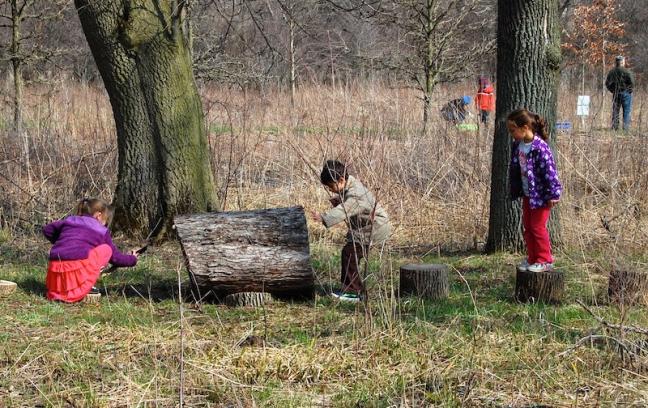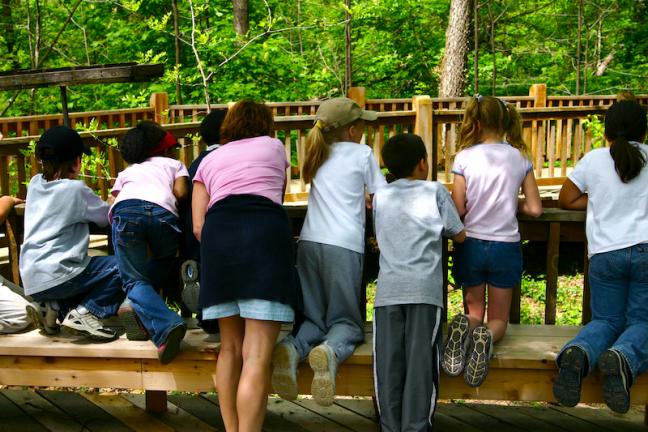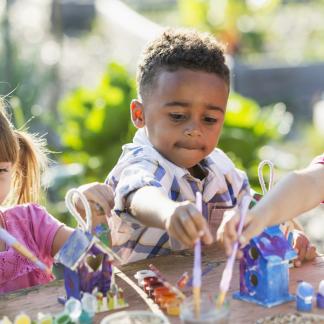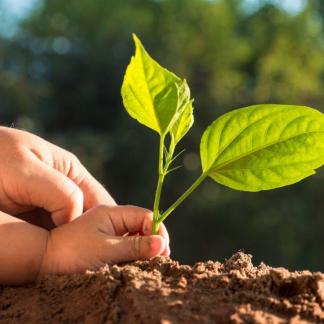A field trip to a nature center, zoo, wildlife refuge, lakeshore, or other nature destination can enrich young children’s lives and education in innumerable ways. It makes learning more joyful, tangible, authentic, and meaningful; it connects children to the larger world around them; and, it uses children’s natural capacity for wonder as a springboard for inquiry and learning. The natural setting also enables children to use and develop all of their senses and exercise their imagination in a more relaxed interpersonal environment. Not lastly, a nature field trip introduces children to people in the community who make a living by caring for plants, animals, and natural areas.
Fortunately, educators and caregivers do not need to “know” a lot about nature or have formal training in outdoor education to bring these benefits of fields trips to their children. Some intentional planning before, during, and after a field trip will help you to facilitate a safe and rewarding learning experience for your students and make the most of the opportunity to learn with and in nature.
Here are some ideas for three key phases of a field trip with preschool and kindergarten students to a nature destination:
Before the Field Trip: Seek Developmentally Appropriate Content
A field trip that is effective and developmentally appropriate for younger children will be designed differently than one for older children. When communicating with staff at the destination you’re considering for a field trip, describe your group and ask if the setup, materials, activities, and schedule of the field trip can be matched to the developmental level of your children. Ensure that the educators and volunteers at the destination are prepared to support your students’ learning styles and development needs.
For example, topics explored during the field trip should be familiar and easy for young children to experience first-hand through their senses, and the schedule should allow for choice and freedom of movement from activity to activity rather than follow a strict, predetermined rotation between activities.
In particular, ask about opportunities for the children to:
- explore and discover the world of nature on their own terms and at their own pace;
- engage in inquiry, hands-on experimentation, and problem-solving;
- learn how to care for other living things.
Also ask about the possibility of incorporating an unstructured nature play period of a minimum of 20 minutes into the field trip and whether the children should wear outdoor clothes that are okay to get dirty. An increasing number of nature destinations, including zoos, nature museums, and even nature preserves, have play areas that encourage full body movement and loose parts play.

If the field trip will contain a nature hike, it should focus on discovery and exploration and follow the children’s lead and interests. It should feature frequent stops and provide plenty of time for child-directed play. Request that group leaders facilitate this interactive hike model rather than lead an “interpretive” or “guided” hike with a pre-planned script.
Another important question for your field trip hosts is whether any natural elements might pose a risk to the participants (for example, poison ivy, bees, standing bodies of water, etc.), and how that risk will be managed during the trip. If any of your children have known environmental allergies, note them in your conversation with your prospective host and then plan for them accordingly.
A safety and risk management discussion provides a good segue for talking about the appropriate child/adult ratio for your field trip and how to best communicate the ethics of visiting a natural destination to young children. Schedule appropriate transition times for arrival, use of facilities, and continued hydration for the group to ensure the children are comfortable and at their best to enjoy the entire experience.
Finally, ask if the children will “meet” or learn about the habitat or needs of specific animals or plants at the site. Ask for book recommendations that can spark children’s interest and are appropriate for their level, or other resources that you can use with the students to whet their curiosity and generate questions they can bring with them to the field trip.
During the Field Trip: Help Children Experience the Joy and Wonder of Nature
Going through the above list of pre-trip considerations will help you feel prepared, and your children gleefully expectant, when you arrive on site!
Ensure that you have an adequate number of adult chaperones to support the safety of each child and effectively engage in authentic interactions with nature. The more chaperones, the better. For example, if the field trip features a hike, make sure that there are, at minimum, one adult in the front and one in the back. Aim to have groups of no more than 3-4 children.
Any site-specific rules, such as respecting nature and refraining from picking flowers, should be conveyed to the children in simple and concrete language that helps them understand the rationale behind them. Set clear expectations for the children in your group by recognizing them as stewards of nature who are aware and protective of it. Focus on what children can do rather than what they cannot do. For example: “In this area we only look with our eyes at the flowers, but we can touch and even climb trees in the next area of the field trip!”
Nature provides never-ending sources of surprise and delight -- especially for young children. During the field trip, provide plenty of ways for the children to experience and interact with nature, from quiet observation to active investigation. Move at their pace as much as possible and follow their initiative. Instead of telling them what this or that animal or plant is, use open-ended questions and encourage them to ask “I wonder how...”, “I wonder why...”, and other questions that enable them to be inquisitive, formulate theories, look for evidence, and share their findings, ideas, and feelings with others. Consider bringing small notebooks and pencils for the children to serve as nature journals. Children can note and illustrate their impressions and discoveries throughout the field trip or during a scheduled silent time under the shade of a tree.

Your key roles are to challenge children’s ideas (both correct and incorrect) about the things they encounter in nature, and create opportunities for them to find out more information rather than give them the factual answer. As the great biologist and author, Rachel Carson, noted:
If a child asked me a question that suggested even a faint awareness of the mystery behind the arrival of a migrant sandpiper on the beach of an August morning, I would be far more pleased than by the mere fact that he knew it was a sandpiper and not a plover.
After the Field Trip: Reflect On and Extend the Learning
Keep the children’s sense of wonder and curiosity alive, and extend their learning when they’re back in the classroom, by providing resources that can help them further explore the topics which caught their attention during the field trip. Children can also draw or write about the things they found most interesting during the field trip, or create their own nature center, botanic garden, or other type of destination that they visited, out of building blocks.
Practice gratitude for those who care for nature and invite the children to write or draw a thank-you letter to the nature facility staff. This activity helps the children to reflect on their visit and identify which parts resonated with them. You can create a large thank-you card from the entire class, or mail individual letters from each child.
You can also use this opportunity to bring nature to your students. For example, you can install a bird feeder outside the classroom window and track its visitors, or plant flowers or herbs in windowsill pots and care for them, or incorporate loose nature parts, such as tree cookies, into your classroom permanently.
You can even encourage your children’s families to visit that same nature destination and let the children be their “guides”. If there’s a cost associated with the site, ask for free passes for the students’ families -- most nature-based organizations will work with you to ensure that cost is not a barrier to a family visit.
In Summary
A successful field trip is one that provides ample opportunities for joyful interaction with nature and helps children develop a desire to learn more about the world around them. By planning activities and a schedule that are developmentally appropriate for young children, you can use a trip to a nature destination as a way to foster students’ curiosity while helping them understand and appreciate the larger community of life of which they are a part.
About the Author
Emilian Geczi, PhD, is Director of the Natural Start Alliance, a project of the North American Association for Environmental Education to support parents, educators, researchers, and others who help young children connect to nature and care for the environment.
He wishes to thank Melissa Mulvaney, Coordinator of the All Day Program and Lead Teacher at Seton Montessori School, and Reagan Miller, Executive Director at the Gertrude B. Nielsen Child Care and Learning Center, for the incredibly helpful feedback and suggestions on a first draft of this article.




